Introduction
“How well can you visually tell a structured story?”
Through both visual and written mediums, Freestyle students learned how to identify and create compelling narrative stories with symbolism, developed characters, and a three-act structure. We learned how to use valuable applications like Adobe Illustrator, ProTools, and Wacom Digital Drawing Pads to more effectively tell our stories.
The common theme woven throughout this unit was to show, not tell. I found that this statement drastically improved my writing, illustration, and filmmaking skills because it pushed me to try and evoke emotion in an audience without using words. Furthermore, it was a helpful phrase to apply to my work whenever I felt like a particular scene or paragraph needed revising.
Story
During this unit in English, we studied and discussed symbolism and narrative structures in George Orwell’s 1984. This taught me a lot about how historical events influence fictional books, and how fictional books can influence the present and future. We applied the skill of brevity which we learned from reading various short stories to our own Flash Fiction stories, within which we practiced fictional storytelling using well-developed characters, imagery, and limited dialogue. To assist our writing process, we completed a Character Questionnaire and created a Plot Map. I am much more comfortable writing literary analysis essays, so the Flash Fiction assignment pushed me out of my comfort zone and taught me how to communicate my perspective through fictional writing.
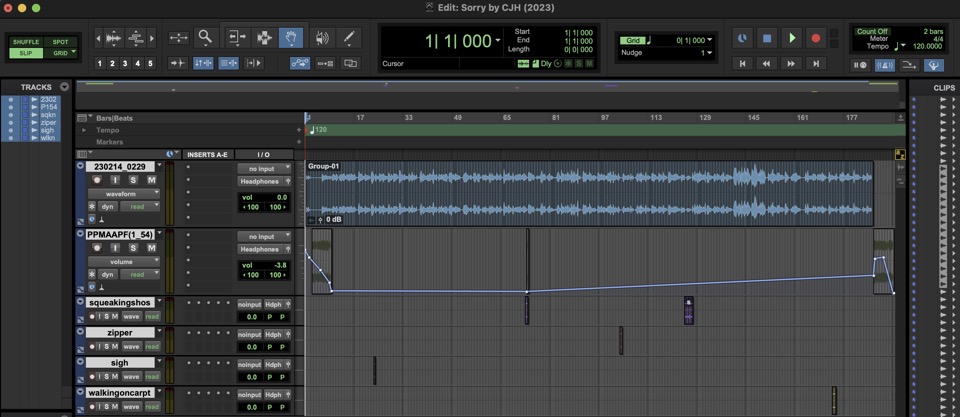
In Digital Media, we recorded our Flash Fiction short stories on our Tascam audio recorders and learned how to edit the audio and add sound effects in ProTools. I valued getting to translate my written story into an auditory one because it gave me more control over expressing my story in the way I wanted the audience to interpret it. Adding deliberate sound effects and music specifically helped me enhance the emotions in my story. We then learned how to use Adobe Illustrator and Wacom Digital Drawing Pads to design album art for our short stories.
“Sorry” by CJ Hoo
Anna Davis was watching billboards race across the yellow-tinted windows of her mother’s silver Ford Focus. Glimpses of her own reflection occasionally flashed in the glass. With oval framed glasses, a muddy brown tie-dye shirt which was supposed to be rainbow, and formerly hot pink Skechers, Anna was the spitting image of eleven years old. She tried to press her feet against the back of the driver’s seat like she used to do, but her legs no longer had space to straighten all the way.
Anna let out a deep sigh, hoping her mom would hear. Yes, Anna had wanted to go to the toy store, but not in the middle of Mr. Mocha’s makeover! She had just been repainting her favorite mug’s eyelashes when her mom had practically dragged her away. His smiling brown eyes and the circular blush on his cheeks were now lonesomely waiting for her return. She remembered leaving him on the floor, but now worried he was face down on her pink shag carpet.
However, Mr. Mocha’s possible predicament completely faded from mind as The Toys “R” Us sign appeared ahead, reflecting a growing rainbow over Anna’s wide eyes. The toy store never failed to brighten her day. If she squinted, the quotations around the “R” looked like wings; Anna flew out of the car and stopped to wait under the colorful sign. She swore her mom had never opened the car door so slowly before.
When they stepped inside, her mom was already holding her phone to her ear. “10 minutes,” she mouthed. Anna knew arguing with that was like breaking a wall with a marshmallow. Pencil case, she told herself. Pencil case, pencil case. She had promised she would leave the store with nothing more than a pencil case, but she knew that distractions on another planet like this were inevitable. Racks of Disney characters, action figures, and construction vehicles sitting in their cardboard homes lined Anna’s peripheral vision and blended into a tunneling kaleidoscope as her now salmon-colored Skechers squeaked across the reflective tile floor. Anna tried to avoid eye contact with a shelf of sparkly Beanie Boos.
“Sorry,” she whispered. She wished she could give them a warmer, less cardboard-y home. At least the stationary aisle will be easy, she told herself.
But the stationary aisle was New York City: skyscraping shelves filled with pencil cases and coloring kits nearly touched the fluorescent ceiling lights. Everything smelled like new plastic, everything demanded to be touched, and everything had a face. Grumpy pencils and laugh-crying erasers scrutinized Anna, who tried to hide behind her glasses. Pick me, pick me, they whispered. Anna forced herself to pick the case in her direct line of vision so that she wouldn’t have to look around anymore. The chosen one was lemon yellow, had two upturned blue eyes, and a red zipper that looked like a smiling mouth; she opened it to let it breathe. The zippers on the other pencil cases seemed to droop into a frown as she walked away.
“Sorry,” she told them.
The Beanie Boos followed Anna with their glimmering eyes as she walked back to her mother at the front of the store. Anna was Orpheus, and the toys were Eurydice. Behind her, she heard their short-snouted smiles whisper her name. She tried to focus on the bubblegum pink shoelaces bouncing off the floor like a game of eternal tennis.
“Anna, It’s been sixteen minutes.” Her mother called, standing ahead in the checkout line with her hand covering her phone’s speaker. The tone of her voice made Anna itchy and hot.
Only a few more squeaks from her Skechers…
Anna turned around.
“No.” Her mom said.
“But I didn’t even—” Anna’s voice matched the pitch of her sneakers on the tile floor.
“No.”
Her mom’s mouth flattened into a thin pencil case zipper… She couldn’t hear the other pencil cases fruitlessly gasping for air through their closed zippers, couldn’t see the Beanie Boos’ eyes well with tears. Shaking her head, she turned the case over in Anna’s hands and opened her zipper.
“Everything in this funhouse has a face on it, but it’s all fake, did you know that? Three dollars for the zipper-mouth, an extra dollar if you want it to be red, two dollars for the eyes, and another dollar for the blue. You’re not making a friend, you’re buying one. I let you come to this store for an errand- if you know what that is- not to throw money and tears at every pair of plastic eyes that you see!”
Anna didn’t know, but she knew suddenly that the acrid smell of plastic filled her nose, and that the reflection of fluorescent lights on the sterile white tiles was blinding. Her glasses betrayed her by fogging up immediately. She knew it was time to wave her final goodbye, which now the toys scarcely saw with their two-dollar eyes.
Back in the car, the yellow tint of the windows muted the bright pink and blue on the Toys “R” Us sign to a muddy brown. The billboards trudged along next to them and occasionally flashed dollar through the murky windows.
Mr. Mocha was indeed waiting on the floor when Anna walked into her room, but he was face down as she had feared. When she turned him over, she saw that his new eyelashes had smeared into the pink carpet and now streaked down his face onto his porcelain cheeks. His eyes were glazed over, and patches of lint stuck to the half-dried paint.
Anna turned the mug over and traced the edges of a wrinkled four-dollar price tag.
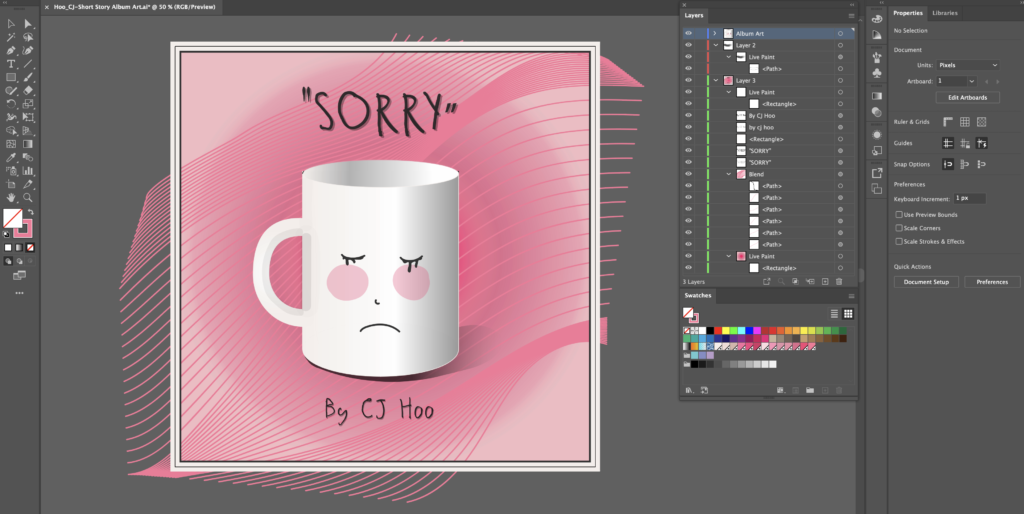
Illustrations
As mentioned previously, we focused on learning how to use Adobe Illustrator to create visually compelling stories and concepts. I particularly appreciated this because I had never before tried making digital drawings or art; I was only accustomed to drawing with a pencil and paper. I think digital drawing is a very useful skill to have for future employment opportunities in the age of technology, so I value everything that I learned during this unit.
I really enjoyed collaborating with my classmates on the Exquisite Corpse assignment because their creativity and talent inspired me push myself outside of my comfort zone. The assignment involved four of us each creating one part of the body to portray our theme, ‘Wonderland’, using Adobe Illustrator- while not knowing what our other group members were drawing.

The Adobe Illustrator project gave us more creative freedom than any other project I have experienced at Freestyle so far. Students chose between a final, tangible product of clothing, stickers, mugs, etc., onto which they printed their designs. I chose to create stickers that look like vintage stamps. Each stamp has a different flower on it which is personally meaningful to me.
“Floral Memories” Artist Statement
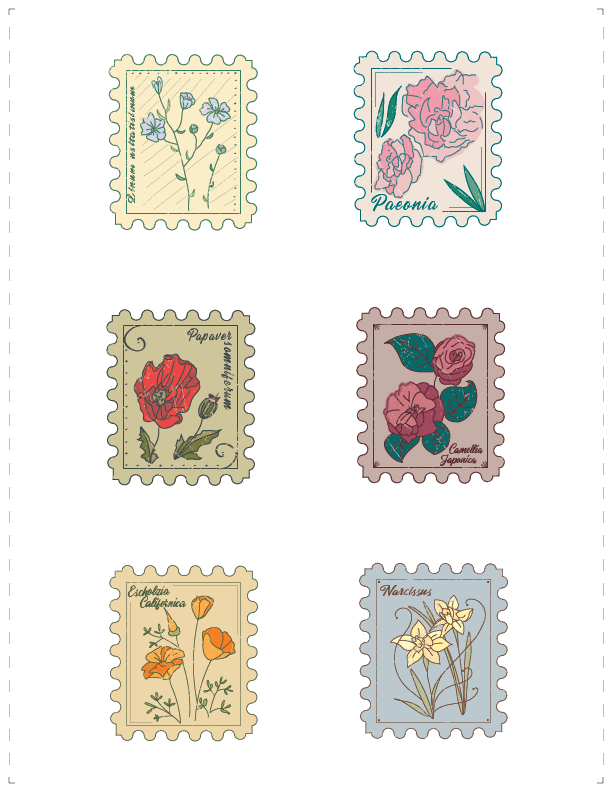
The inspiration for my project was flowers that carry symbolism in my life. I wanted to represent memories and different periods of my life through these flowers. For example, the wildflowers- the flax flowers, poppies, and California poppies- grow in my yard every spring and are a comforting reminder of my childhood. Peonies were the flowers in my mother’s wedding bouquet, daffodils are the March birth month flower (I have a March birthday), and I have had a camellia tree outside my bedroom window for as long as I can remember.
I feel like I generally grew as an artist throughout the duration of this project by experimenting with a new medium, Adobe Illustrator. Prior to Digital Media and Freestyle, I had never dabbled in digital art because I was more accustomed to just using pencil and paper. However, I have now learned how to use a Wacom Tablet and the Pen and Brush Tools in Illustrator to draw digitally. This project also taught me to become very comfortable with the Live Paint Tool in Adobe Illustrator, which saved me a lot of time.
About halfway through this project, my dog jumped on my desk and broke my iMac screen, but I was able to finish my artwork on my Macbook even though the screen is a lot smaller. However, I found that I prefer the smaller screen because I feel like it allows me to be more detailed and examine my drawing more closely.
If I could change anything about my project, I think I would make the flowers more realistic. Because I had never used Illustrator or drawn digitally before, I wasn’t confident that I would be able to draw as well as I could on paper. However, now that I am more comfortable with Illustrator, I would like to add shading and more details to my art.
Overall, I’m very proud of what I accomplished throughout the duration of this project because again, this was the first time that I experimented with digital art. I’m proud that I successfully created a product that is meaningful to me and relates to my personal life. I am most proud of the color schemes that I used for the stamps because I believe that they are vibrant, yet aged, which is what I was trying to portray. I particularly like my poppy stamp with the bright red flower against the muted green background. This project definitely made me admire digital artists more because I can now relate to the process, although at a much different level of experience.
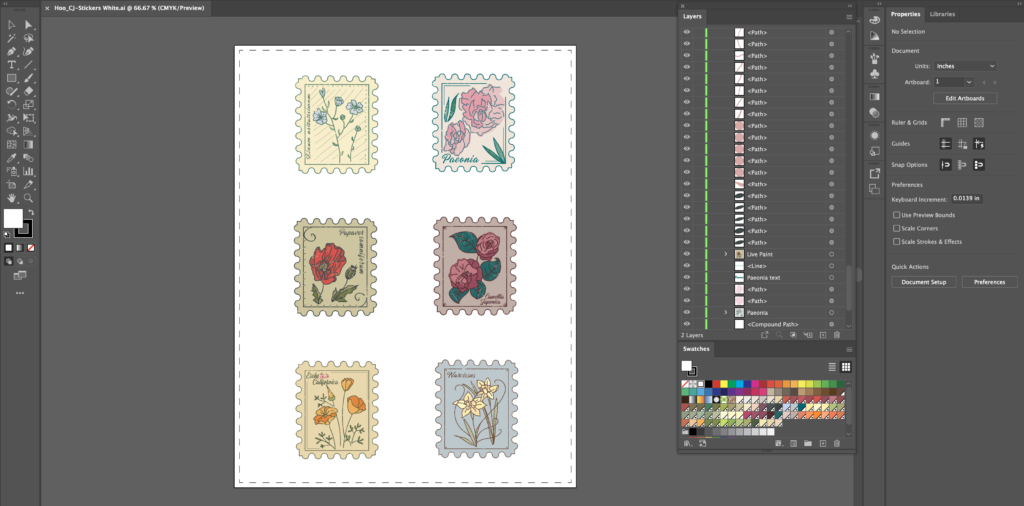
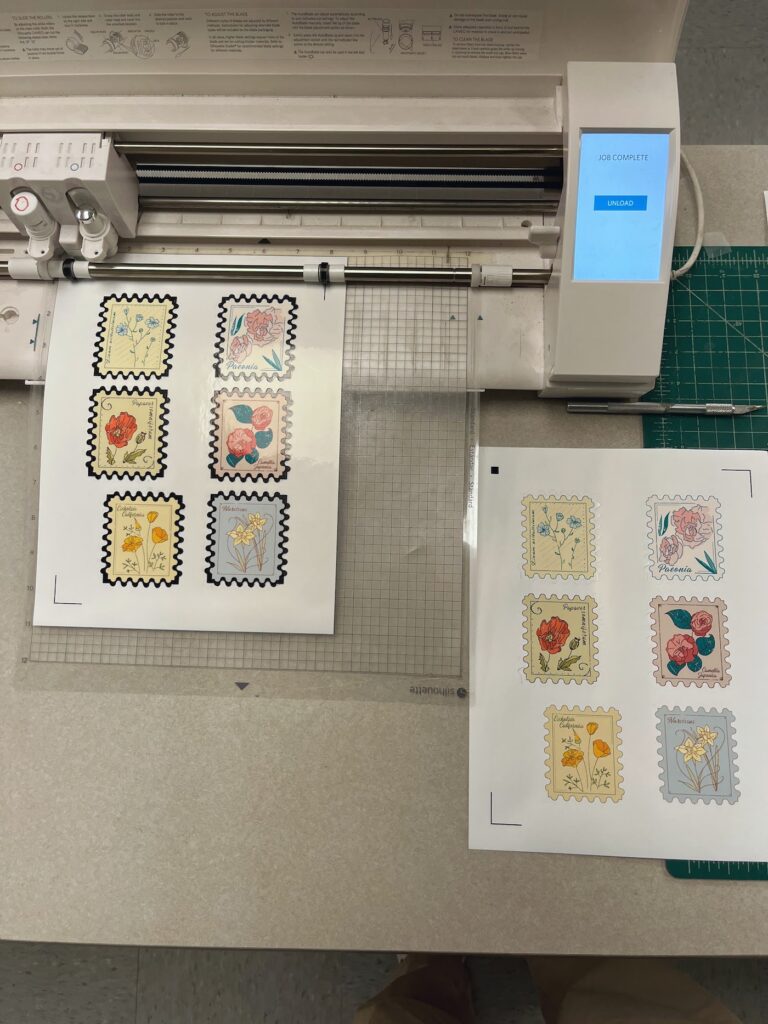
Music
Also in Digital Media, we used ProTools to create a song mash-up and a parody song. We specifically learned how to remove the vocals from our chosen song by splitting a stereo track into two mono tracks, inserting an equaliser, and adding a low pass filter to the final audio among other steps. My friend Natalie and I decided to parody Taylor Swift’s “Better Than Revenge” to describe our our frustrations towards nepotism and “nepo babies” in the entertainment industry. We found the process of writing new lyrics extremely amusing, and we even poked fun at ourselves for mocking said “nepo babies”.


“Merit-Not-Cracy” by CJ Hoo and Natalie Emerson
The story starts when she was born and she had everything
And I had nothing I had Twitter and jealousy
There are blue underlines for every member of her family tree
She got the job faster than you could say nepo baby
I always saw it coming always had suspected it
But I overestimated just who I was dealing with
She has to know that fame is not just knowing Spielberg
She overestimated how much money gives her worth
She looks at life like it’s a party and she’s on the A-list
She looks at us like we don’t work like she’s so talented (spoken)
I think that her parents 90s peak is a little annoying
And, she thinks I’m bitter
‘Cause I dont have front row at the Emmys, but
Sophistication isn’t what you wear, or who you know
Or pushing people down to get you where you wanna go
Oh they didn’t teach you that in prep school
So it’s up to me
But no amount of vintage dresses gives you dignity
Auditions aren’t her thing and she’s bad at everything
It’s genetics
She’s better known for her parents names
In the credits
Soon she’s gonna find
Generational wealth and connections
Won’t give you any talent
She should keep in mind
She should keep in mind
Hating on nepo babies is my habit
And do you still feel like you got here by destiny
‘Cause I don’t think you do, oh
Do you still feel like you got here by destiny
I don’t think you do, I don’t think you do
Let’s hear the applause
C’mon show me how much better you are
See you deserve some applause
‘Cause you’re so much better
she got the job faster than you could say nepo baby
Film
During Film this unit, we wrote, directed, and edited our own narrative films. We spent months in pre-production learning how to storyboard effectively, and filmed over the span of a month. We also dove deeper into film language and practiced it through short exercises like the Griffith’s Pattern exercise, the Suspense Scene, and the Chase Scene. It was challenging to create a compelling narrative without dialogue, but it also pushed us to “show, not tell” and instead to rely on composition and shot types to tell our stories.
Learning about Griffith’s Pattern gave us the tools to create a successful narrative film because it introduced us to film language. I really enjoyed working on this scene with my friends; it was hard to keep a straight face when I was pretending to compete with them.
The Suspense Scene incorporated Griffith’s Pattern, but we expanded upon this by introducing an important element of story: suspense. I learned how to “encode” a POV shot, and I had a good time working with my friends. It wasn’t our best work, but we learned how to correct our mistakes concerning POV shots, the 180 degree rule, and story structure.
The Chase Scene was the most strenuous short scene that we created this year. We learned about the 180 degree rule and other concepts important to communicating in film language. Unlike the others, we worked alone on this assignment, and our teacher critiqued our work as if we were at a professional level. I remember that the days leading up to the in-class critique were very stressful, but they were also beneficial because they improved my self-critiquing skills.
Narrative Synopsis
The main character is a girl who lives alone with her dog and wants friends. It’s evident from her messy house that her life is not put together- she makes sludge for breakfast. She looks outside her window one morning and sees her productive neighbor coming back from an early morning bike ride with grocery bags. The productive girl waves at the messy girl, who is jealous of the other’s lifestyle. The messy girl turns her attention away and watches TV with her dog for most of the day. Later, the messy girl hears music, but she’s not sure where it’s coming from- she decides to go outside and figure it out. She realizes that the music is coming from the productive girl’s house, who is dancing and baking in her kitchen.
At this point, the messy girl decides that she is going to get her life together. She goes back inside and circles Christmas Day on her calendar- the viewer doesn’t yet know what she’s preparing for. The main character wakes up early the next morning, washes her face, showers, and drinks lemon water. The tasks bring her no joy, but she intermittently looks out the window and sees her neighbor also getting ready for the day. This gives her motivation to power through and convinces her that it’s worth it; beauty is pain. The next few days pass by in a montage of the main character getting ready for the day and getting her life together- however, she begins neglecting her dog because she is only spending time on her self image now. On the morning of Christmas Eve, both girls go outside to collect their mail, only the messy girl’s mailbox is empty, and the productive girl’s is full. The productive girl waves and quickly goes back inside. The next morning- Christmas day- the main character does her routine and gets dressed up. She starts baking Christmas cookies, but fails multiple times. We see that she cares more about the appearance of the cookies than her dog. After baking for a while, she looks up and hears people talking/sees that her productive neighbor has friends over. The messy girl finally finishes her cookies and goes over to deliver the cookies to her productive neighbor. When the productive girl opens the door, she seems surprised and uncomfortable, and we get a glimpse of her house for the first time. However, instead of people, there are cardboard cutouts of people, and a speaker playing a tape of a conversation.
She realizes that her neighbor’s lifestyle is completely fabricated. The neighbor sees that the main character knows this and slams the door. The main character goes back home and shares the Christmas cookies with her dog. She goes back to her former lifestyle and realizes that she feels bad for the “productive” girl. She makes the sludge from the beginning and goes over to offer breakfast to her neighbor. The movie ends with both of them eating together (not looking productive) at the main character’s house.
(Main character is unproductive and lazy. She sees a new neighbor move in across the street and is envious of her productive lifestyle. The main character attempts to imitate her neighbor’s habits- playing music and dancing, going on a run, setting up a Christmas tree, buying the same clothes. She becomes obsessed with becoming her neighbor.) (Then, her neighbor sends her an invitation to her holiday party, making the main character really excited. Main character puts a lot of effort into getting ready for the party because she wants to impress her neighbor. When she arrives at her house, she notices that something is off- no one is talking or moving. She sits down and sees that everyone else is dead (climax) and also kind of looks like her- maybe we can assume that all of her other victims also wanted to be like the neighbor.) (Main character tries to escape the house, but everything is locked. She tries to hide in the bathroom, but then the neighbor shows up next to her in the mirror and kills her.) The mirror symbolizes how the main character tried so hard to become the neighbor.
Originally, Tegan and I wrote a Christmas horror film, but we scrapped it after discovering many holes in the plot structure. This process goes to show how we have learned to persevere and keep revising throughout the process of filmmaking.
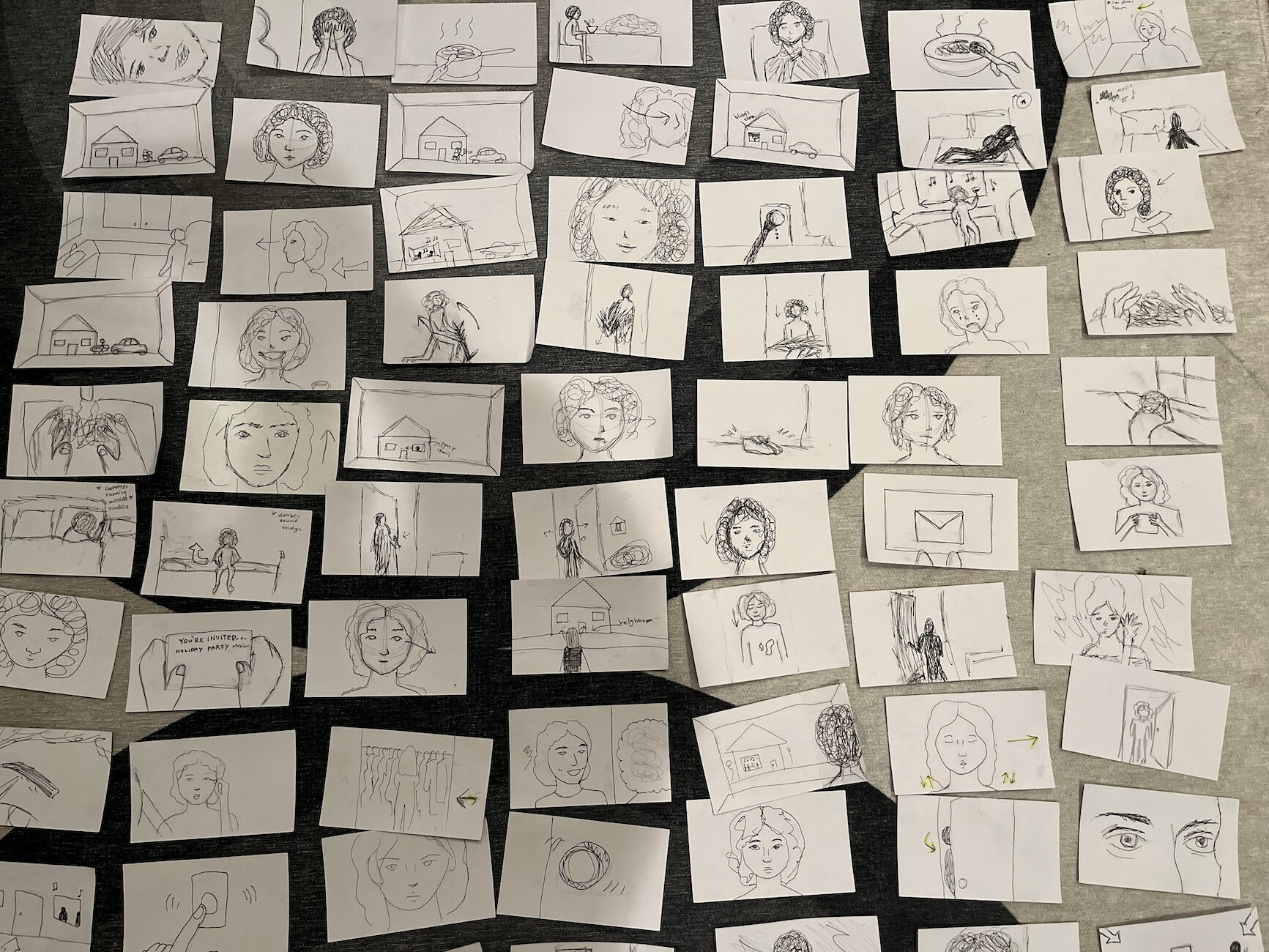
We learned how storyboarding and preproduction are crucial in the making of a film in order to be more efficient during actual production. We then spent over a month working on our own storyboards; my partner and I created three complete storyboards (100+ notecards each) because we changed and revised our idea so many times. This was overall a tedious, yet rewarding experience.


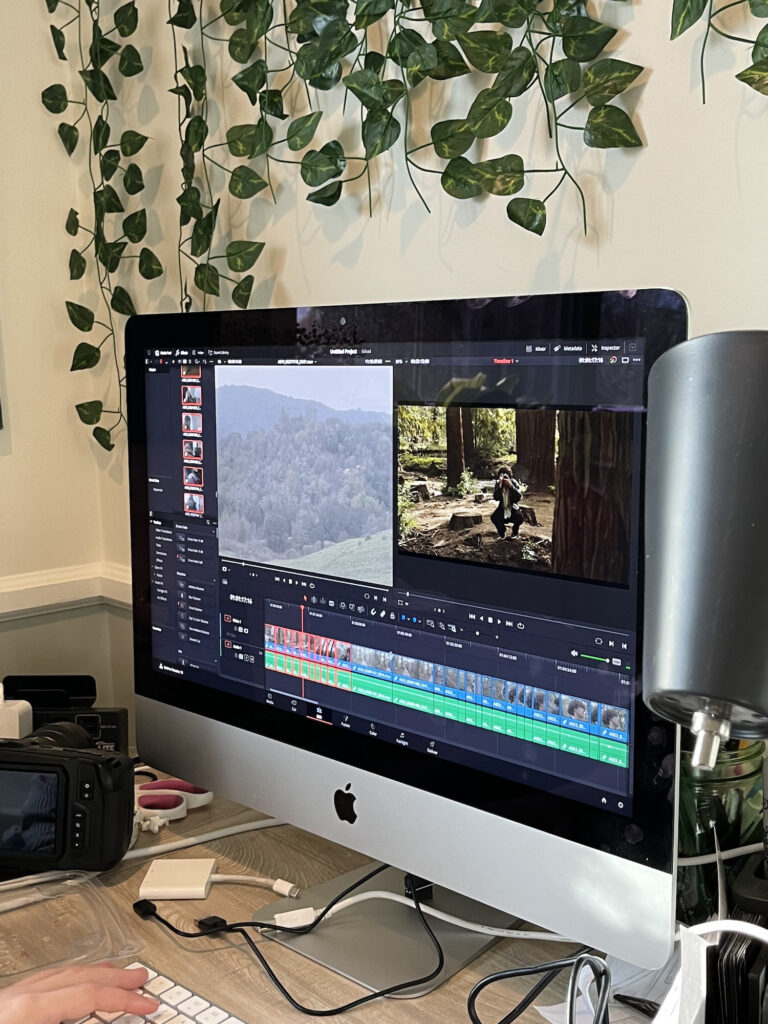
To film our narrative movie, my partner Tegan and I used her Blackmagic Pocket Cinema Camera, which presented us with the challenge of importing our large files into Premiere Pro to edit. Overall, the Narrative 1 unit in film required countless hours of time spent planning and filming, and I learned how to direct actors and operate different types of cameras. In a broader sense, I learned how to better problem solve and collaborate with others on a long term project.